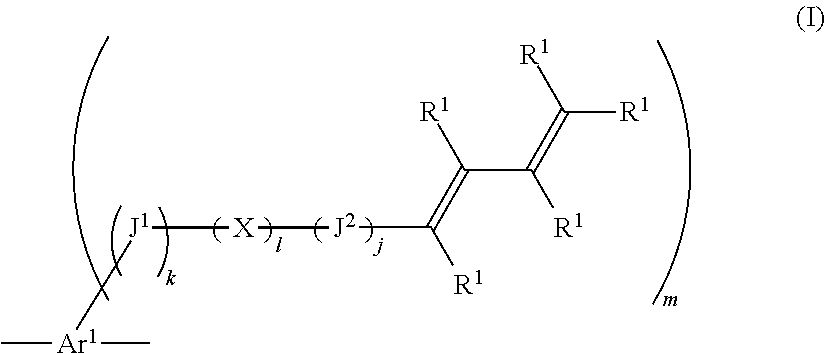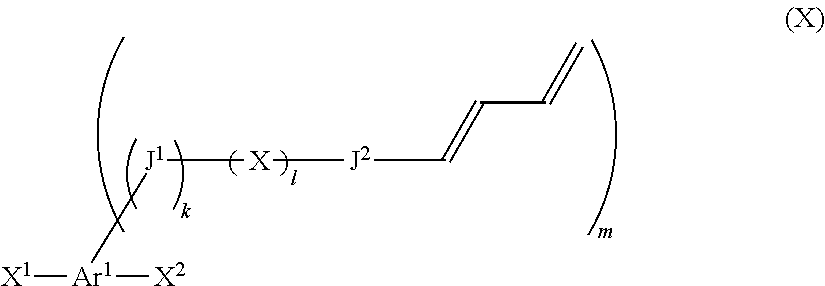Compound containing 1,3-diene structure and method for producing same
a technology of 1,3-diene and compound, which is applied in the direction of thermoelectric device junction materials, solid-state devices, light sources, etc., can solve the problem of insufficient hardening ability of the above compound, and achieve the effect of excellent hardening ability
- Summary
- Abstract
- Description
- Claims
- Application Information
AI Technical Summary
Benefits of technology
Problems solved by technology
Method used
Image
Examples
synthesis example 1
Synthesis of Compound M-1
[0286]
[0287]Under an argon atmosphere, divinylcarbinol (25.24 g), triethyl orthoacetate (340 g) and propionic acid (0.20 g) were blended and warmed to 130° C. for 4 hours while removing ethanol by use of Dean-Stark. After completion of the reaction, the resultant reaction solution was cooled. To the reaction solution, hexane (300 ml) and ion-exchanged water (300 ml) were added, and stirred at 60° C. for 3 hours. After layers were separated, an organic layer was washed with ion-exchanged water (300 ml×3 times) and dried over sodium sulfate. The resultant organic layer was concentrated by passing it through an alumina flush column. To the resultant oil, again, hexane (300 ml), ion-exchanged water (300 ml) and propionic acid (0.20 g) were added and stirred at 60° C. for 8 hours. After layers were separated, an organic layer was washed with ion-exchanged water (300 ml×3 times) and dried over sodium sulfate. The resultant organic layer was concentrated by passing...
synthesis example 2
Synthesis of Compound M-2
[0289]
[0290]Under an argon atmosphere, compound M-1 (14.65 g) and diethyl ether (770 ml) were blended and cooled to 0° C. Subsequently, to the resultant solution mixture, a 1 M lithium aluminum hydride ether solution (50 ml) was added dropwise for one hour and stirred for one hour while the temperature was kept at 0° C. To the resultant reaction solution, a 5 wt % aqueous sodium hydroxide solution (100 ml) was slowly added dropwise and quenched. Thereafter, an organic layer was washed with water (100 ml×3 times) and the organic layer was dried over sodium sulfate. The resultant organic layer was concentrated by passing it through an alumina flush column to obtain compound M-2 (8.0 g) represented by the above formula M-2.
[0291]1H-NMR (270 MHz, CDCl3): δ=1.67 (tt, 2H), 2.13-2.28 (m, 3H), 3.63 (q, 2H), 5.04 (dd, 2H), 5.72 (dd, 1H), 6.07 (dd, 1H), 6.30 (m, 1H) ppm.
synthesis example 3
Synthesis of Compound M-3
[0292]
[0293]Under an argon atmosphere, compound M-2 (18.98 g) and dichloromethane (730 ml) were blended and cooled to 0° C. To the resultant solution mixture, triethylamine (58 ml) was added dropwise and then methane sulfonylchloride (24 ml) was added dropwise and stirred for 2 hours while the temperature was kept at 0° C. To the resultant reaction solution, water was added and quenched and thereafter, extraction with ether and dehydration over sodium sulfate were performed to obtain yellow oil (32 g).
[0294]Under an argon atmosphere, the yellow oil (32 g), lithium bromide (36 g) and THF (400 ml) were blended and refluxed for 7 hours. The resultant reaction solution was cooled and ion-exchanged water (200 ml) and toluene (500 ml) were added and then, layers were separated. The organic layer was washed with ion-exchanged water (100 ml×5 times) and dried over sodium sulfate. The resultant organic layer was concentrated. After hexane (100 ml) was added, the orga...
PUM
| Property | Measurement | Unit |
|---|---|---|
| molar ratio | aaaaa | aaaaa |
| molar ratio | aaaaa | aaaaa |
| molar ratio | aaaaa | aaaaa |
Abstract
Description
Claims
Application Information
 Login to View More
Login to View More - R&D
- Intellectual Property
- Life Sciences
- Materials
- Tech Scout
- Unparalleled Data Quality
- Higher Quality Content
- 60% Fewer Hallucinations
Browse by: Latest US Patents, China's latest patents, Technical Efficacy Thesaurus, Application Domain, Technology Topic, Popular Technical Reports.
© 2025 PatSnap. All rights reserved.Legal|Privacy policy|Modern Slavery Act Transparency Statement|Sitemap|About US| Contact US: help@patsnap.com



